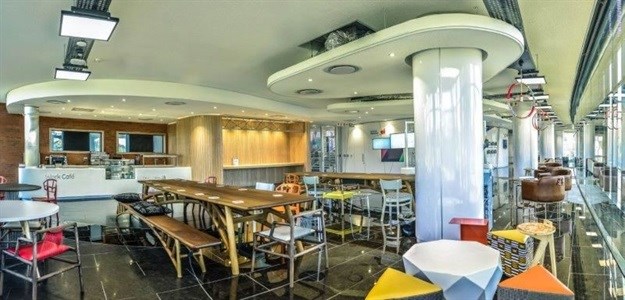The GE Africa Innovation Centre (GEAIC) in Melrose Estate, Johannesburg has received top sustainability accreditation from both South Africa and the US, thanks to a collaboration between architecture and interior architecture specialist Paragon Group, and integrated infrastructure delivery company AECOM.
Not only has the GEAIC clinched a Green Star Interior rating from the Green Building Council of South Africa (GBCSA), it also boasts a Leadership in Energy and Environmental Design (LEED) Silver rating from the US Green Building Council (USGBC). Both the Green Star and LEED ratings are essential for GE as a global company, which ensures its sustainability credentials are recognised in Africa and the rest of the world.
The building, with a gross lettable area (GLA) of 2,454m², is located in close proximity to the key commercial and shopping precinct of Rosebank in Johannesburg. Consisting of a three-storey, mainly east-facing glazed structure, it takes advantage of the extensive African sunlight and mild climate, with access and parking on the west, while overlooking a golf course to the south.
The publicly-accessible ground floor has a health-focused work café and digital exhibition centre, collaboration zones, and an outdoor collaboration area. The first floor is restricted to tenants only, and incorporates agile workspaces, as well as a fully-equipped GE Africa Healthcare training centre.
The top floor includes a flexible learning and development centre, collaboration rooms, and a multi-disciplinary laboratory. Facilities have been provided for those accessing the building by bicycle or fuel-efficient car. The basement parking features showers and bicycle racks, together with green vehicle bays.
High-performance workplace design

Anthony Karam, senior project architectural technologist, Paragon Group
The Paragon Group oversaw the interior fit-out. “The vision was to provide accessibility to a healthy environment, and internalise this in the workplace, promoting an integrated and balanced health and wellness-driven work environment,” Paragon Group senior project architectural technologist Anthony Karam comments.
Furthermore, the design called for localising a global company’s identity within the African context, forming a place where ‘GE and Africa meet’. The overall design serves as a dynamic collaboration between various African artistic drivers and high-performance workplace design.
AECOM was appointed to carry out full engineering services for the project, including project management and sustainability. The latter encompassed all electrical and mechanical services. One of the most stringent sustainability requirements for the dual rating was the energy-consumption criteria.
This included the HVAC, the domestic hot water system, and even appliance selection. The building is monitored through a network of submeters to assist facilities management in operating it efficiently. Waste management was also crucial during construction, and a requirement during operation. The project achieved a high level of diversion from landfill.
During construction, an on-site commissioning agent, reporting to both the Paragon Group and AECOM, administrated the commissioning process. This was to ensure that all building systems would operate post-completion as per the initial design requirements. Simultaneously, AECOM engineers guided sub-contractors, making certain that all LEED processes were followed to completion.

Candice Manning, sustainability practice area lead, AECOM
Significant achievement
AECOM sustainability practice area lead Candice Manning says the USGBC accreditation is “a significant achievement, as there are only a handful of LEED-rated projects in South Africa. We are certainly very proud of being at the vanguard of managing the certification process for both Green Star and LEED rated projects in Africa”.
According to Manning, the major challenges of the GEAIC project was complying with the various standards and benchmarks of both rating systems, as well as the seamless management of these processes. She also regards these as the project’s greatest achievements.































